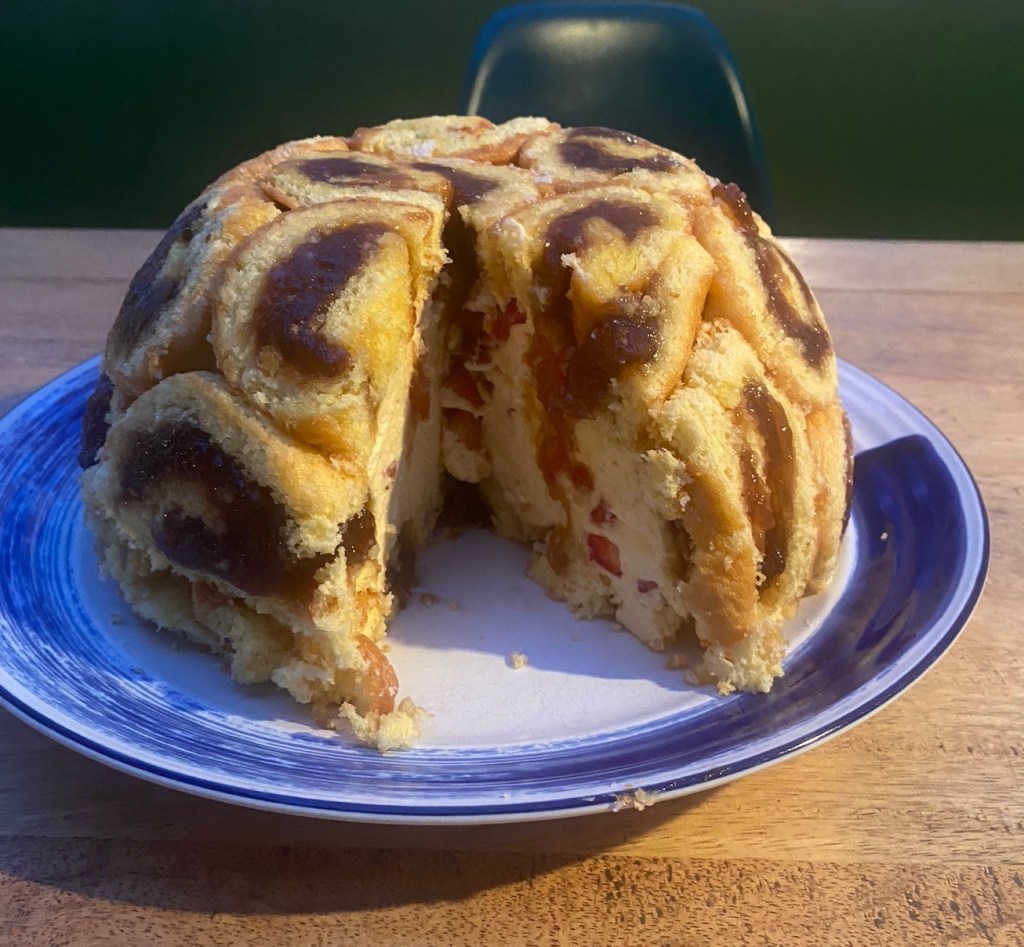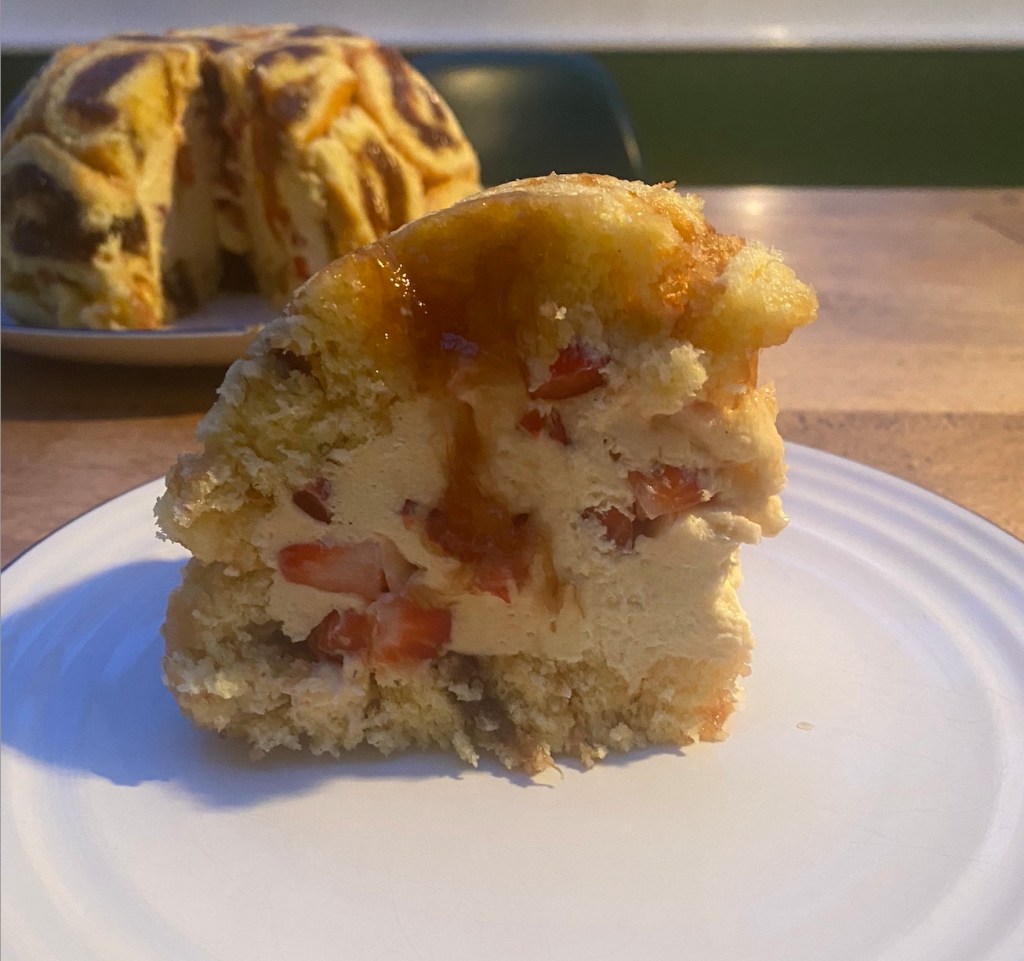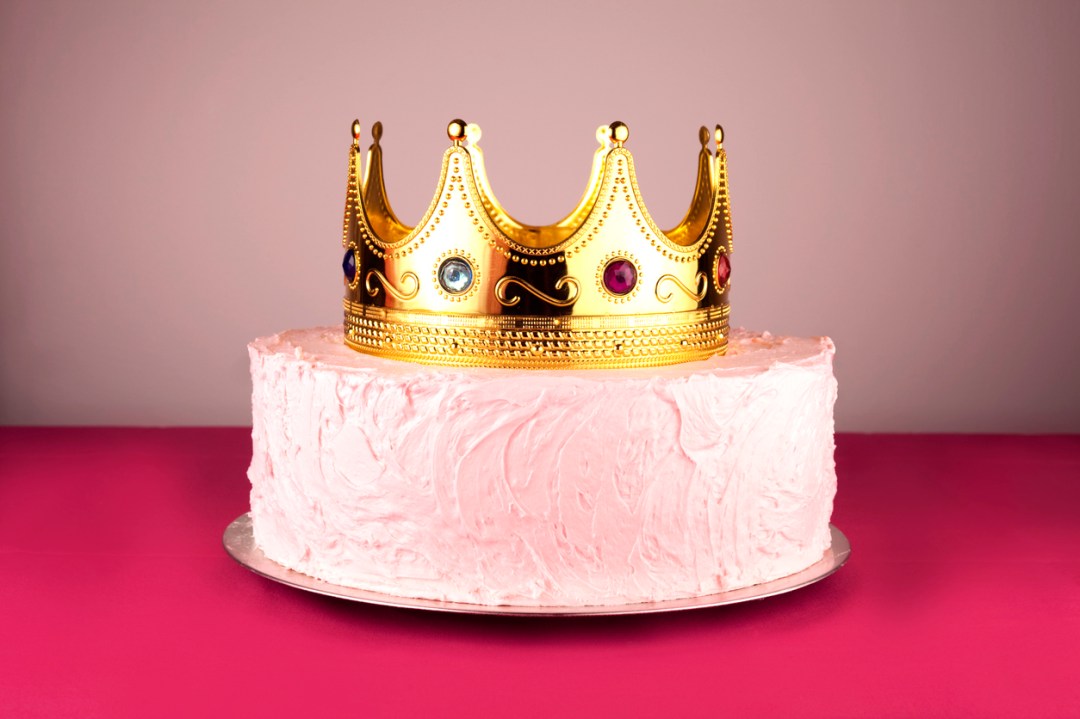The big bank holiday weekend is about to begin. You’ve made that spinach and broad bean quiche. The bunting’s ready for your street party. You’ve crafted a coronation drinking game. But there’s something missing, isn’t there? An itch that just needs to be scratched. Where’s the pizazz? Where’s the cake? As the oft-misattributed quote goes: a party without cake is just a meeting. I know, I know: a quiche can be fun, but is it celebratory?
No, what we need is a good old over-the-top, lily-gilded showstopper of a cake, that you can cut into with appropriate levels of pomp and circumstance. And, boy, do I have the pudding for you. It’s hard to think of a more appropriate pudding to celebrate the coronation of a King called Charles than a Charlotte Royale.
A Charlotte Royale is a fancy (and slightly ridiculous) version of the already-quite-fancy Charlotte Russe. In both puddings, a bavarois – a custard set with gelatine, and then loosened with whipped cream – is surrounded by a light sponge. A Charlotte Russe has a ring of ladyfingers circling the creamy filling, while a Charlotte Royale uses a jam-filled Swiss roll, and is set inside a round mould bowl, before being turned out upside down, so that its dome is on top. Really, it’s a wibbly custard in a sponge frame; a trifle that you can cut into slices and serve like a cake.
Really, it’s a wibbly custard in a sponge frame; a trifle that you can cut into slices and serve like a cake
A Charlotte pudding was originally fruit (usually apple) purée moulded and baked inside buttered slices of bread. But the cold, cream-based version originated at the beginning of the 19th century and came from the French chef Antonin Carême. Carême was a chef to the stars (and the Tsars), cooking for Tsar Alexander and George IV when he was Prince Regent, and there is suggestion that the first Charlotte Royale was made for Queen Charlotte, the wife of George III.
The recipe below is for a rhubarb and strawberry Charlotte Royale, with rhubarb jam inside the Swiss roll, and little jewels of strawberry studded through the vanilla custard. I love the contrast of the tart fruit with the rich, sweet custard, and rhubarb and strawberries are natural bedfellows. May is their moment of crossover, with the very earliest British strawberries arriving as deep pink rhubarb reaches its height. But there’s a lot of room for personal taste here. Showcase whichever jam you like, although the bolder the colour, the greater the contrast with the builder’s tea-coloured sponge. The custard can be flavoured with lemon zest or almond extract, a strong booze or delicate orange blossom, while the pieces of fruit can be anything small and soft – other berries work well, as do stone fruits such as cherries, or poached plum or apricot.
I’m not going to tell you to make your own jam; I’m not even going to tell you to make your own custard – just buy a pot of the good, pale, vanilla-freckled stuff and use that – but I am going to gently suggest that you make your own Swiss roll, only because you then have free rein with your choice of jam filling. But if you fancy having a crack at it, but distinctly do not fancy the idea of whisking up a genoise sponge, just buy two or three ready-made Swiss rolls. The bavarois can seem intimidating, but the key is only to let the custard cool to room temperature, and not overwhip the cream. If the custard hasn’t yet set, and the cream is still soft and pliable, combining the two is easy.
It always feels like a little miracle turning something out of a mould, and seeing it stand proudly, without support. This feels particularly true of a Charlotte Royale, with that cool, creamy, just set-custard, studded with diced strawberries surrounded by the cross-section of the Swiss roll, with the crimson jam swirling hypnotically over the domed shape, like some kind of optical illusion. It is truly a pudding fit for a King.

Rhubarb and strawberry Charlotte Royale
For the Swiss roll
6 large eggs, at room temperature
150g caster sugar, plus 2 tablespoons
150g self-raising flour
330ml rhubarb jam
For the filling
500ml thick custard
5 leaves of gelatine
300ml double cream
200g strawberries, hulled and diced
- If you’re making your own Swiss roll, preheat the oven to 200°C and line two Swiss roll trays (a raised-edge oven tray measuring approximately 20 x 30cm). Whisk the eggs and sugar together until very thick and pale, and significantly increased in volume: the mixture should trail off the whisk in a ribbon, and sit on top of the rest of the mixture for a couple of seconds before it starts to sink in.
- Sift the flour into the mixture and fold in gently, trying not to knock too much air out. Divide between the two trays, and bake for 10 minutes. While the sponges are baking, lay two sheets of greaseproof paper on the worktop, and sprinkle a tablespoon of caster sugar over each. As soon as the sponges come out of the oven, turn them on to the sugared paper. Trim the edges, and score along the long side, 2cm from the long edge, being careful not to cut all the way through the sponge. Spread the jam across the two sponges, then roll up tightly, starting from the scored edge.
- Soak the gelatine leaves in very cold water. Heat the custard gently in a pan until hot but not boiling. Squeeze the water out of the gelatine, and then drop in the custard, and whisk into the custard. Stir thoroughly, making sure the gelatine is completely melted into the custard. Remove from the heat and transfer custard to a bowl. Leave to cool until the custard is thickening and has cooled to room temperature, but is not cold.
- Line a large bowl (mine has 2.5 litres capacity) with clingfilm. Slice the Swiss roll into 1cm slices, and line the bowl with them, placing them tightly together, with as few gaps as possible. Reserve enough slices to cover the top of the bowl.
- Whisk the cream to very soft peaks. Fold into the cooling custard, and then stir through the diced strawberry pieces. Pour this into the sponge-lined bowl, and top with the remaining Swiss roll slices. Refrigerate overnight, before turning out, and removing the clingfilm.

Join The Spectator’s Fraser Nelson, Katy Balls and guest Camilla Tominey from the Daily Telegraph for a special edition of Coffee House Live covering what kind of monarch Charles III will be, and whether the coronation will distract voters from the Tories’ predicted heavy losses in the local elections. 10 May from 7 p.m. Book your tickets today.







Comments